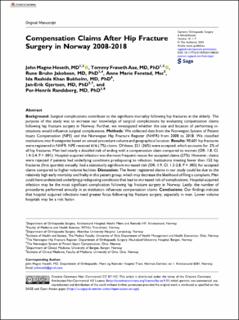| dc.contributor.author | Hoseth, John Magne | |
| dc.contributor.author | Aae, Tommy Frøseth | |
| dc.contributor.author | Jakobsen, Rune Bruhn | |
| dc.contributor.author | Fenstad, Anne Marie | |
| dc.contributor.author | Bukholm, Ida Rashida Khan | |
| dc.contributor.author | Gjertsen, Jan-Erik | |
| dc.contributor.author | Randsborg, Per-Henrik | |
| dc.date.accessioned | 2023-10-26T09:02:38Z | |
| dc.date.available | 2023-10-26T09:02:38Z | |
| dc.date.created | 2023-08-28T12:26:19Z | |
| dc.date.issued | 2023 | |
| dc.identifier.citation | Geriatric Orthopaedic Surgery & Rehabilitation (GOS). 2023, 14 . | en_US |
| dc.identifier.issn | 2151-4585 | |
| dc.identifier.uri | https://hdl.handle.net/11250/3098871 | |
| dc.description.abstract | Background
Surgical complications contribute to the significant mortality following hip fractures in the elderly. The purpose of this study was to increase our knowledge of surgical complications by evaluating compensation claims following hip fracture surgery in Norway. Further, we investigated whether the size and location of performing institutions would influence surgical complications.
Methods
We collected data from the Norwegian System of Patient Injury Compensation (NPE) and the Norwegian Hip Fracture Register (NHFR) from 2008 to 2018. We classified institutions into 4 categories based on annual procedure volume and geographical location.
Results
90,601 hip fractures were registered in NHFR. NPE received 616 (.7%) claims. Of these, 221 (36%) were accepted, which accounts for .2% of all hip fractures. Men had nearly a doubled risk of ending with a compensation claim compared to women (OR: 1.8, CI, 1.4-2.4, P < .001). Hospital-acquired infection was the most frequent reason for accepted claims (27%). However, claims were rejected if patients had underlying conditions predisposing to infection. Institutions treating fewer than 152 hip fractures (first quartile) annually, had a statistically significant increased risk (OR: 1.9, CI, 1.3-2.8, P = .005) for accepted claims compared to higher volume facilities.
Discussion
The fewer registered claims in our study could be due to the relatively high early mortality and frailty in this patient group, which may decrease the likelihood of filing a complaint. Men could have undetected underlying predisposing conditions that lead to increased risk of complications. Hospital-acquired infection may be the most significant complication following hip fracture surgery in Norway. Lastly, the number of procedures performed annually in an institution influences compensation claims.
Conclusions
Our findings indicate that hospital acquired infections need greater focus following hip fracture surgery, especially in men. Lower volume hospitals may be a risk factor. | en_US |
| dc.language.iso | eng | en_US |
| dc.publisher | SAGE Publications | en_US |
| dc.rights | Navngivelse-Ikkekommersiell 4.0 Internasjonal | * |
| dc.rights.uri | http://creativecommons.org/licenses/by-nc/4.0/deed.no | * |
| dc.title | Compensation Claims After Hip Fracture Surgery in Norway 2008-2018 | en_US |
| dc.title.alternative | Compensation Claims After Hip Fracture Surgery in Norway 2008-2018 | en_US |
| dc.type | Peer reviewed | en_US |
| dc.type | Journal article | en_US |
| dc.description.version | publishedVersion | en_US |
| dc.source.pagenumber | 0 | en_US |
| dc.source.volume | 14 | en_US |
| dc.source.journal | Geriatric Orthopaedic Surgery & Rehabilitation (GOS) | en_US |
| dc.identifier.doi | 10.1177/21514593231188623 | |
| dc.identifier.cristin | 2170176 | |
| cristin.ispublished | true | |
| cristin.fulltext | original | |
| cristin.qualitycode | 1 | |

